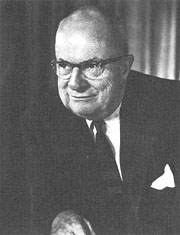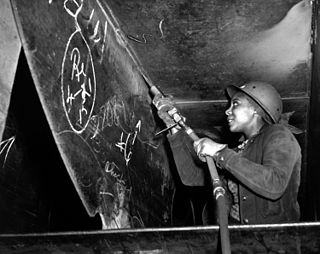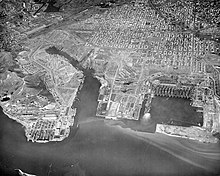
Vigor Shipyards is the current entity operating the former Todd Shipyards after its acquisition in 2011. Todd Shipyards was founded in 1916, which owned and operated shipyards on the West Coast of the United States, East Coast of the United States and the Gulf. Todd Shipyards were a major part of the Emergency Shipbuilding Program for World War II.

Henry John Kaiser was an American industrialist who became known for his shipbuilding and construction projects, then later for his involvement in fostering modern American health care. Prior to World War II, Kaiser was involved in the construction industry; his company was one of those that built the Hoover Dam. He established the Kaiser Shipyards, which built Liberty ships during World War II, after which he formed Kaiser Aluminum and Kaiser Steel. Kaiser organized Kaiser Permanente health care for his workers and their families. He led Kaiser-Frazer followed by Kaiser Motors, automobile companies known for the safety of their designs. Kaiser was involved in large construction projects such as civic centers and dams, and invested in real estate, later moving into television broadcasting. With his wealth, he established the Kaiser Family Foundation, a nonprofit, non-partisan, charitable organization.

Rosie the Riveter World War II Home Front National Historical Park is a United States national historical park located in Richmond, California, near San Francisco. The park preserves and interprets the legacy of the United States home front during World War II, including the Kaiser Richmond Shipyards, the Victory ship SS Red Oak Victory, a tank factory, housing developments and other facilities built to support America's entry into World War II. In particular, the role of women and African-Americans in war industries is explored and honored.
Permanente Metals Corporation (PMC) is best known for having managed the Richmond Shipyards in Richmond, California, owned by one of industrialist Henry J. Kaiser's many corporations, and also engaged in related corporate activities. These four of the seven west coast Kaiser Shipyards were known for their construction of Liberty ships and later Victory ships.

Oregon Shipbuilding Corporation was a World War II emergency shipyard located along the Willamette River in Portland, Oregon, United States. The shipyard built nearly 600 Liberty and Victory ships between 1941 and 1945 under the Emergency Shipbuilding program. It was closed after the war ended.

The four Richmond Shipyards, in the city of Richmond, California, United States, were run by Permanente Metals and part of the Kaiser Shipyards. In World War II, Richmond built more ships than any other shipyard, turning out as many as three ships in a single day. The shipyards are part of the Rosie the Riveter/World War II Home Front National Historical Park, whose Rosie the Riveter memorial honors the shipyard workers. Shipyard #3 is listed on the National Register of Historic Places and is a California Historical Landmark # 1032.

The Emergency Shipbuilding Program was a United States government effort to quickly build simple cargo ships to carry troops and materiel to allies and foreign theatres during World War II. Run by the U.S. Maritime Commission, the program built almost 6,000 ships.

The Kaiser Company , commonly known as the Swan Island Shipyard, was a shipyard on Swan Island in Portland, Oregon, United States. It was constructed by the industrialist Henry J. Kaiser in 1942 as part of the U.S. Maritime Commission's Emergency Shipbuilding Program in World War II. The Swan Island yard was one of three Kaiser Shipyards in the Portland area, along with the Oregon Shipbuilding Corporation and the Vancouver Shipyard.

The Ocean ships were a class of sixty cargo ships built in the United States by Todd Shipyards Corporation during the Second World War for the British Ministry of War Transport under contracts let by the British Purchasing Commission. Eighteen were lost to enemy action and eight to accidents; survivors were sold postwar into merchant service.

The SS Drexel Victory was a Victory-class cargo ship built during World War II. The SS Drexel Victory (MCV-712), was a type VC2-S-AP2 victory ship built by Permanente Metals Corporation, Yard 2, of Richmond, California under the Emergency Shipbuilding program. The Maritime Administration cargo ship was the 744th victory ship. Her keel was laid on February 25, 1945. The ship was christened on May 2, 1945. The ship was named in honor of Drexel University in Philadelphia, one of 150 educational institutions that had Victory ships named after them.
SS Francisco Coronado was a Liberty ship built in the United States during World War II. The ship was named after Francisco Vázquez de Coronado y Luján, a Spanish conquistador who explored the southwestern United States between 1540 and 1542. The ship was built at the Kaiser Shipbuilding Company's shipyard at Vancouver, Washington.

SS India Victory was a Victory ship built and operated as a cargo carrier and troopship in World War II. After the war the ship was used a private cargo ship. She sank on 12 July 1972, ran aground on a Pratas Reef in the South China in Typhoon Susan.

SS Augustana Victory was built and operated as Victory ship class cargo ship which operated as a cargo carrier in World War II, and Vietnam War.

SS Fordham Victory was built and operated as Victory cargo ship which operated as a cargo carrier in World War II. For the war she was operated by the Weyerhaeuser Steamship Company under charter with the Maritime Commission and War Shipping Administration.
Northland Transportation Company operated cargo and passenger ships from Seattle to Southeast Alaska starting in 1923. During World War II Northland Transportation Company was active in charter shipping with the Maritime Commission and War Shipping Administration. Northland Transportation Company, proposed a loan from United States Shipping Board to build a ship for Puget Sound-Alaska trade in 1933. In 1934, the company was granted a $350,000 loan to build a new ship. The 1,400 tons passenger ship, was built at Lake Washington Shipyard in Houghton, Washington. Northland Transportation Company Seattle dock and warehouse were at Pier 56, now Ainsworth and Dunn Wharf.














